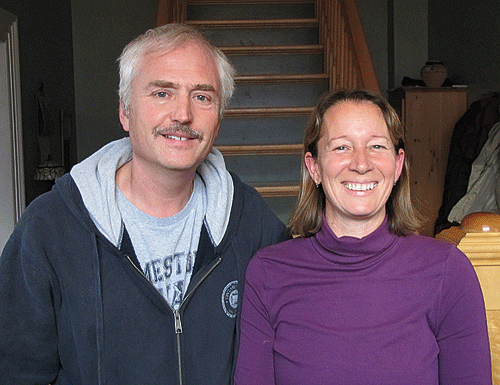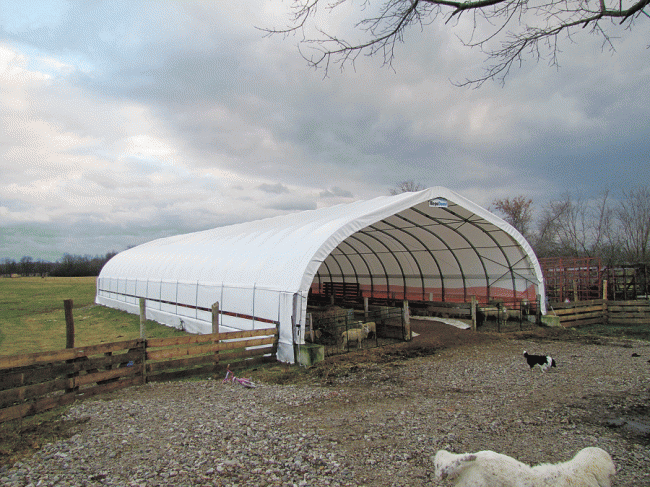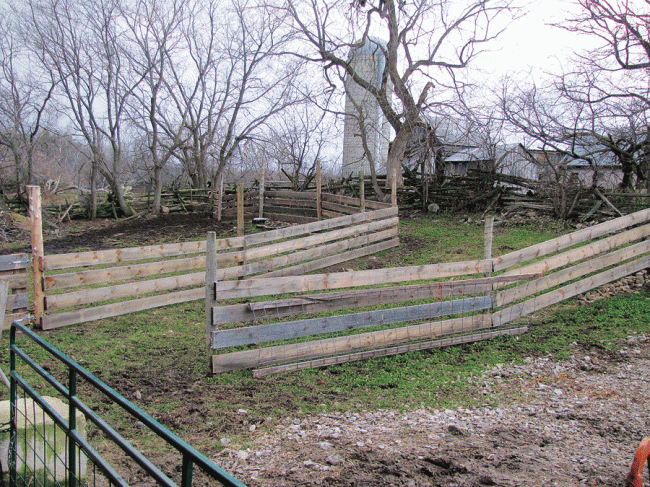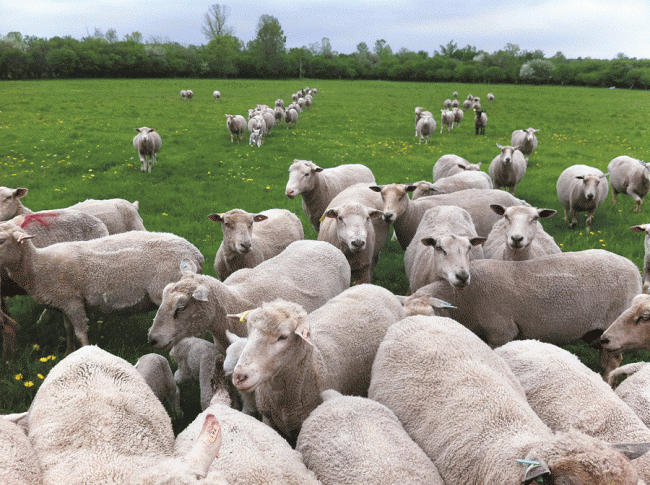Story by Cathy Gallivan, PhD, Photos by Allison Taylor, PhD
Oliver and Sarah Loten have been raising sheep for 20 years and, like most sheep farmers, have made a lot of changes to their flock and their management in that time.
They started on a hobby farm near Carleton Place, when they were both working full time, Sarah as a teacher and Oliver in information technology. Fourteen years ago they decided to make sheep farming their way of life. They looked for a large farm that would be suitable for sheep and ended up buying 300 acres of rough (class 4-6) land near Perth with a lovely old stone house. An older dairy barn with an attached cinder block barn provided shelter for sheep and hay storage. The Lotens have since replaced the old cedar rails and single strand fence with a perimeter of page wire and five-strand high tensile electric fence and subsequent subdivisions, which is still ongoing. They have also added three greenhouse-type buildings, or ‘tunnels’, which are used to store hay and equipment, and also as shelter for ewes and lambs.
To feed the flock and produce cash crops they bought an additional 275 acres, which Oliver describes as good, but rocky (class 1); there is another 65 acres of leased land. Here they produce forage for the sheep, which is usually put up as round bale silage. They also grow corn, soybeans and small grains.
Living close to a major city means being close to markets and off-farm work, but also means putting up with non-agricultural development. One of the first things the Lotens did upon purchasing their land was to develop and file a Nutrient Management Plan, which predicted the nutrient (manure) production of their livestock and determined the land base required for its use. They filed a plan for up to 2,500 ewes (and their lambs), leaving lots of room for future expansion. By registering this plan ahead of any proposed developments in their area, they have been able to restrict development around them.
After moving to the new farm, Oliver and Sarah built a flock of 1,000 ewes. Like many sheep farmers who build large flocks from several sources, they found that some of the sheep they acquired were a better match for their operation than others. In the early days they tried pasture lambing but had problems with mis-mothering and lost or abandoned lambs. So they moved to indoor lambing and even tried accelerated lambing for five years. Lambing in a barn gave them more control over the ewes and lambs, but brought with it an increased workload that quickly became overwhelming. And the lamb death loss was still too high.
When they reached the point where they just couldn’t continue spending so much time with individual animals at lambing time, they decided to scale the flock back to 500 ewes and expand again with stricter criteria for lambing and raising lambs unassisted, even if it meant giving up some prolificacy. The flock now stands at 700 ewes again, and Oliver and Sarah plan to get back to 1,000 ewes and to market 1,700 lambs each year.

The centre feeding aisle is filled with sand; strips of the tunnel material are attached to the feeders to hold grain delivered from a side-delivery cart pulled by an RTV. This material is easily swept clean.
Most of the current flock is a mix of Dorset and Rideau Arcott, known in Ontario as OLIBS, after the Ontario Lamb Improvement Breeding Strategy that promoted this type of ewe back in the 1990’s. These were purchased from John and Eadie Steele, of Norwood, Ontario. There are also some Coopworths, from Foot Flats Farm on Amherst Island, Ontario. Although a little less prolific than the OLIBS-type ewes, Sarah says they do super well on pasture, the ewes are great mothers and they produce a very marketable lighter lamb. The Lotens also buy their guardian dogs from Foot Flats.
The flock now lambs in two groups. In the winter, when the farm is quiet, they lamb 150 ewes in the old dairy barn. In the spring, when they are busy with cropping and the start of haying, the rest of the flock lambs on pasture, in two paddocks close to one of the tunnels, where it is easy to keep an eye on them.
Now that they have the right ewes for the job, the Lotens find they only have to check the ewes two or three times a day. They provide the ewes with what they need to give birth and rear their lambs successfully, and then stay out of their way and let them do it. Newborn lambs only get handled if there is a problem; there is no docking or castrating, and RFID tags are applied when the lambs leave the farm. Sarah describes this system as ‘shepherd heaven’, after so many years of penning every ewe and her lambs in the barn and delivering feed to them.
They used to use a Kubota RTV to drive around the lambing ewes and check them. But because the RTV is used for feeding, the ewes tended to stop whatever they were doing and run out to meet it. When the RTV burned in a fire, they started using one of several horses on the farm to check the lambing ewes, and found they preferred it. Checking from a horse takes a little longer, but it’s quieter and gives them a better chance to observe the behaviour of the ewes.
Mature ewes are given a chance to raise triplets, but the Lotens also have an automatic milk replacer machine for rearing quadruplets or other lambs found struggling on the pasture. If a ewe loses a lamb or her lambs get into trouble, an X is sprayed on her back, and she no longer gets a second or third chance to cause trouble.
The mature ewes are bred to OLIBS-type rams or to British Suffolk terminal sires, and spend the whole year outside, except for the 150 head that lamb in the winter. They are vaccinated and wormed prior to lambing, and selectively wormed again at weaning. Udders are checked at shearing; the Lotens find that they have much less mastitis since they started lambing on pasture.
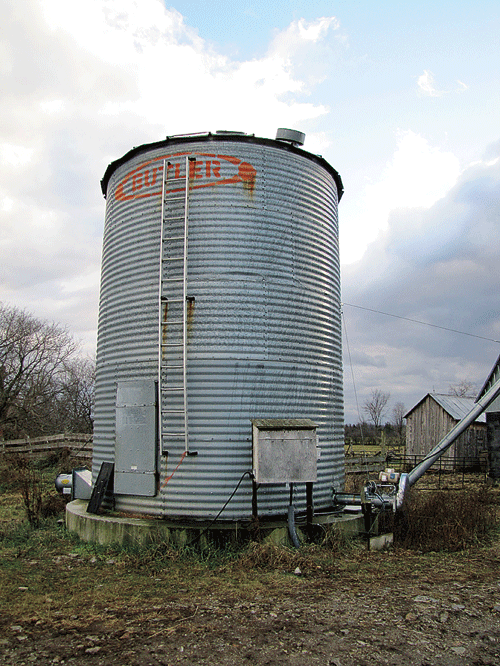
Oliver and Sarah got this large bin used for storing corn for the cost of moving and setting it up. Electric fans at the bottom are used to dry corn.
In the winter, the flock is fed round bales of hay or silage that are unrolled on the ground. They also get corn or barley, delivered from a cart pulled behind the RTV. When the weather is too cold or the snow too deep, the Lotens use a TMR (total mixed ration) wagon they purchased second-hand to deliver chopped hay or silage mixed with corn or barley. The Lotens are debating putting up corn silage in a pit to see if it would be a more cost-effective way of feeding the sheep.
Salt and a custom mineral mix with extra selenium and vitamin E for the winter are provided free choice. In the summer the sheep get salt and trace minerals.
Ewe lambs are bred to Border Cheviot rams and tend to produce a single, very vigorous, lamb. The ewe lambs overwinter in one of the tunnels, starting in mid-December, where they get some extra rations compared to the mature ewes. They usually lamb out in the tunnel in May.
Much of the future expansion of the flock will come from bought-in ewe lambs, including 100 that have been ordered from the Steeles this fall. Oliver and Sarah prefer to focus on what they are good at and delegate other activities to people who are good at them. They aren’t keen record-keepers and prefer to allow the Steeles to keep the extensive records and make selection decisions for them. They have bought animals from the Steeles in the past and found them a good match for their own system.
May-born lambs are weaned in mid- to late July, depending on how well the pasture is holding up. The ewes return to the pasture but the lambs stay inside where they are grown out and finished. Lambs are vaccinated with 8-way and wormed at weaning, and amprolium is added to their water for the first five days to help prevent problems with coccidiosis. They are separated into groups of similar size so that small lambs do not have to compete with big lambs. Small lambs are kept in the old barn and larger lambs moved to the tunnels where the feeders are higher.
The Lotens used to pasture their weaned lambs, and finish them on grain. But coyotes, parasites and the challenges of summer pasture management made it difficult to grow out and finish the lambs in a consistent and uniform manner, so now they keep them inside after weaning.
In 2008, they lost 150 lambs to coyotes. Living so close to the city limited their options for control; complaints about noise from neighbours limit the number of guard dogs they can use, and there are restrictions on trapping in the area.
Like sheep farmers all across Canada, the Lotens have run into problems with resistant worms. With the assistance of their vet, they are trying Cydectin and levamisole. The Cydectin has too long a withdrawal period (two months) to be used on the lambs, but can be used on the ewes. Withdrawal time on the levamisole is only four days, making it ideal for the lambs. Sarah reserves the levamisole for the lambs after they have come into the barn to stay, so that they will not deposit resistant worms on the pasture. She has also tried selective worming (worming only those animals that show signs of parasites) and found it worked for the ewes but not for the lambs. The Lotens also use pasture rotation to limit the spread of worms; the pastureland is divided into 14 paddocks with electric fence.
The lambs are weaned onto a diet of mostly hay, with a small amount of corn that is gradually increased. A 35% crude protein pellet, with Bovatec for continued protection against coccidiosis, is mixed with the corn. The Lotens have also used unprocessed soybeans as a protein supplement. Some of these come from the transfer mix of corn/soybeans that has to be dumped from the combine when it switches from one crop to the next. Sarah says the soybeans work well if the moisture is right and the ratio of soybeans to barley isn’t higher than 1:5, and they save money by not having to process the soybeans. They haven’t fed the soybeans recently because they are worth too much money but will again if the price is right.
In addition to changing the makeup of the flock, the Lotens decided to invest in infrastructure that would make the job of looking after the sheep easier. This included building a permanent handling system in the old dairy barn and putting up the third tunnel four years ago. The tunnel is organized around a central alley that accommodates a side-delivery grain cart pulled by the RTV. Corn is delivered in the cart, then top-dressed with pellets. Round bales of hay are fed right in the pens. Sarah says that making it easier to do the feeding also makes it easier to find someone to feed the sheep, allowing them to occasionally get away from the farm.
Lambs are marketed at the nearby Ottawa Livestock Exchange, which handles 300-600 lambs per week. Oliver takes 15 to 30 lambs at a time, but doesn’t go every week. He says Ottawa is a strong market for heavy lambs (around 90 lb.), while lighter lambs do better at the Ontario Stock Yards at Cookstown.
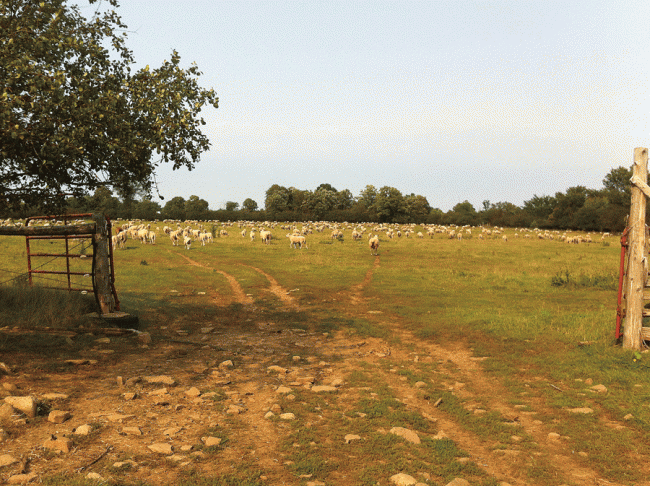
The ewes lamb in one of four paddocks close to the newest tunnel, where it is easy to keep an eye on them. Photo by Sarah Loten.
On the day we visited, Oliver had just returned from delivering a load of lambs to the exchange. He can fit 30 lambs in the trailer, which will be sold in six groups of five. The January-born lambs sell in May and June at 90-95 lb, but if 80-lb. lambs are selling well when these early lambs hit 80 lb., they will let them go at that weight. May-born lambs start selling in September. Oliver often sends a group of small lambs to Toronto around Christmas, and hopes to be all out of lambs by the end of the year.
The Lotens find that selling lambs directly to consumers takes more time than they want to spend, although they usually sell a group of lambs to the Greek Festival each year. As with the record-keeping, Oliver and Sarah know where they do and don’t want to spend their time, and direct marketing of lambs isn’t a priority.
That’s not surprising considering all of their other responsibilities. Oliver works full time off the farm as a technical writer, maintains the farm infrastructure and markets the lambs. Sarah does most of the farming and care of the sheep. She also teaches cello lessons from their home, competes in dressage and gives therapeutic riding lessons after school. The Lotens have five children: Emma (22), Tim (18), Evan (14), Grace (10) and Alice (9). Emma teaches riding lessons and trains horses and Tim will be heading off to university next year. The three youngest children are still in elementary or middle school.
When the Lotens moved to Perth 14 years ago, the goal was to be full time farmers. But they’ve come to enjoy the balance of the activities they do both on and off the farm, paid and unpaid. The farm is central to the family’s economy and lifestyle, with ‘all hands on deck’, but they also value family time in other areas and time spent on other interests and skills developed over the years. Because of this, it is important that labour is used efficiently and that the farm makes a decent profit; but it also offers value as an activity that they enjoy as a significant part of life. Like so many things in life, it is all about balance…


